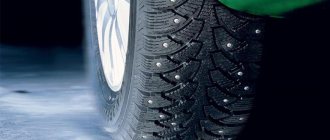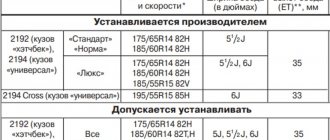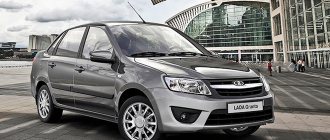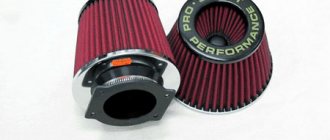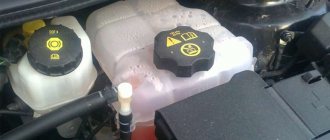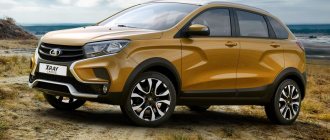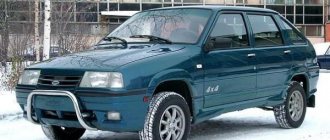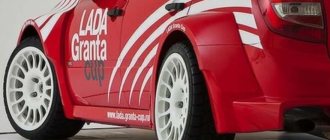The methodology for conducting tests by the Autoreview publication remains the same every year: to take into account the influence of weather conditions and eliminate errors, each test is alternated with races on “base” tires and repeated 10-12 times. In the event of snowfall, longitudinal dynamics testing is carried out on a closed track. As a result, tests on ice were carried out there. But the snowstorm that started on time made it possible to test the tires for cross-country ability in real conditions. Since most of the testing was done in warm weather with temperatures just below freezing, the difference in grip between studded and friction tires was huge.
At the end of the test, the tires were tested on dry and wet roads, as well as for impact strength. An old Mercedes, already “experienced” in this matter, was used as a vehicle for testing strength. It measured the maximum speed that the tire of each model could withstand before a through sidewall puncture occurred when hitting a 94 mm curb at an angle of 45 degrees.
Experts who conducted the tests
Before the start of the 2018-2019 winter season, the 185 65 r15 winter tires were tested by the following automotive publishing houses and expert communities:
- magazine "Autoreview" (Russia);
- magazine "Behind the wheel" (Russia);
- automobile portal "Autocenter" (Ukraine);
- technical supervision society GTÜ (Germany);
- Automobile Club of Europe ACE;
- automobile club ARBÖ (Austria).
Nokian winter tires All of the listed communities are authoritative experts whose opinions have a significant impact on the choice of motorists around the world.
Where did the tests take place?
Traditionally, winter tire tests are carried out in four categories:
- on ice;
- on snow;
- on dry and wet asphalt.
Tests in harsh winter conditions took place mainly at Finnish testing grounds. German professionals preferred the small town of Saariselkä, which is located 200 kilometers beyond the Arctic Circle. The temperature in this place in winter remains stable at -15°C and allows testing different models with dimensions 1 85 65 r15 under absolutely equal conditions.
The Autoreview publication chose the famous White Hell training ground in Lapland, and the Russian magazine Za Rulem tested winter studded tires 185 65 r15 in the northern part of Sweden, in the Norrbotten region on Pirelli tracks. The air temperature ranged from -1°C to -15°C.
Related link:
Winter tires Kama 505 Irbis - the optimal combination of price and quality
Technotrac extreme testing
For testing, a track was chosen in the Finnish village of Ivola in Lapland, which is currently used by many tire manufacturers to test their products. The Technotrac track was created by representatives of the Hankook company, and Russian journalists were the first to be admitted to this training ground.
During testing, temperatures periodically reached -30 degrees, while tire manufacturers cancel their tests when temperatures reach -25 -27 degrees. Frequent snowfalls complicated the tests, requiring maintenance personnel to clean it before testing.
The test car chosen was a Skoda Octavia with front-wheel drive, which has proven itself to be clear and easy to drive, and in order to obtain the necessary test results, it was additionally equipped with special VBOX equipment that measures data based on GPS navigation.
Test participants
For testing, experts selected tires from the world's leading manufacturers. Russian-made tires were also present in the tests organized by the publications Autoreview and Za Rulem.
Let's consider the 8 most popular models that will participate in the comparative test of winter 2018-2022.
- Dunlop SP Winter Ice 02.
- GoodyearUltra Grip Ice Arctic.
- Continental Ice Contact 2.
- Nokian Hakkapeliitta 9.
- Michelin X-Ice North4.
- Hankook Winter I*cept IZ2.
- Nexen Win Guard Snow'G WH2.
Both winter non-studded tires 185 65 r15 and tires equipped with studs take part in the races. For comparison, models with a wheel diameter of 15 inches are taken, but the results can be considered relevant for R14 wheels, since they are almost identical.
Tests Behind the Wheel on asphalt
Testing of the same tires on a clean asphalt surface was already carried out at the AVTOVAZ test site in Tolyatti. The tests were carried out in the spring, so for research in the temperature range of +5 +10 degrees we had to work at night.
First of all, attention was paid to fuel efficiency indicators in combination with maintaining proper directional stability. The first lap is a warm-up lap, speed is 130 km/h, steering movements are smooth (traditional driving mode on the highways).
The Continental tires turned out to be the leader, and there were no comments from drivers about them; they ensured intuitive steering and clear response to commands from the steering wheel. Viatti tires showed the weakest results. They are characterized by a minimum of information content and a significant “zero” zone. In addition, there is a constant risk of the car's rear axle skidding.
Once the tires have received the necessary warm-up, rolling resistance testing can begin, a key parameter affecting fuel efficiency. To ensure that the wind parameter did not play a role, races in both directions of movement were practiced for each set.
Based on the tests carried out, a pair of leaders was formed from Nokian and Nordman. The Chinese Cachland and the German Gislaved are doing the worst. In comparison with the leaders, they provide an increase in gasoline consumption by 0.4 liters at a speed of 60 km/h, and when it increases to 90 km/h, consumption increases by 0.3 liters.
To determine comfort, both the softness of movement and the noise level were taken into account. To draw the most accurate conclusions, service roads characterized by the presence of potholes, continuous cracks and other irregularities were used for testing.
Among the leaders in acoustic comfort were Continental, Hankook and Nokian, but the products of tire manufacturers Cachland and Viatti failed in noise testing. None of the tested samples provided ideal “digestion” of bumps on the road, but the best performance was demonstrated by Cachland, Continental, Hankook, Nokian and Sailun. At least in some places Chinese manufacturers turned out to be the best. The toughest tires were Viatti and Triangle.
To determine the braking distance, tests were carried out on wet and dry surfaces. The speed limit was chosen to be 60 km/h and 80 km/h for each of the conditions. On wet roads, Continental tires perform most effectively, while Nokian and Pirelli perform slightly worse. An outsider of the Viatti tests, providing the need for almost 25% greater braking distance than when installing the tires of the German leader.
On a dry surface, Chinese tires Cachland CH-W2002 won the test, and Viatti again turned out to be an outsider, but this time the gap was only 12.2%.
According to the test results carried out on a “hard” surface, Continental was again in the lead, followed by Pirelli and Nokian in the top three. Chinese tires from Cachland, which became the worst when tested on snow and ice, showed a final fourth result on asphalt. Sailun tires were also in the top six. The Viatti tires lost in all respects, demonstrating poor results in all tests on hard surfaces without exception.
Table of characteristics of tested models
| Features of the spikes | Rubber compound composition | Price* | ||
| Dunlop SP WinterIce 02 | directional V-shaped tread pattern wide grooves for water drainage hard middle part with triangular checkers | Has a rectangular core Enlarged spine base Specially designed seat for the tenon shape | 4D Nano Design Technology Dual-layer tread with soft top layer and stiffer base | 130 dollars |
| Goodyear Ultra Grip Ice Arctic | Tread pattern with wide, sharp-angled grooves Large number of sipes | Triangular design Carbide insert with sharp edges 22 rows of studs over the entire tread surface | The composition contains silicon polymer, which provides additional adhesion to wet surfaces. | 108 dollars |
| Continental Ice Contact 2 | Has an asymmetric tread To improve stability, there are special grooves on the side parts of the tread blocks The slats have a zigzag shape | Extra-light Cristall Dubb studs "ice pockets" around the spikes Crystalline form of thorns High Temperature Fastening | The composition contains a large amount of rapeseed oil, which gives the tires elasticity. Silicon dioxide improves traction. | 130 dollars |
| Nokian Hakkapeliitta 9 | Has a directional tread pattern with deep drainage grooves. Special aramid fibers protect the wheel sidewall from cuts. | Use of two types of studsEco S tud 9 technology allows the studs to gently contact the surface | Green Elasto Proof rubber compound is environmentally friendly | 133 dollars |
| Michelin X-Ice North4 | The central part of the tread has a directional pattern with sharp edges of the blocks. The side blocks are larger and rectangular, which increases cross-country ability. | Smart spike technology Conical studs reminiscent of rally models Fastening with thermoactive mixture Reduced top flange diameter from 6.5 to 5 mm Increased number of spikes (up to 250 pcs) | Improved rubber compound allows tires to remain flexible down to record temperatures of -65°C | 117 dollars |
| Hankook Winter I*cept IZ2 | Reinforced central rib Large number of 3D lamellas throughout the entire surface | Studless tires | Contains highly dispersed silica | 100 dollars |
| Nexen Win Guard Snow'G WH2 | Hard center rib Movable shoulder checkers Rounded side blocks increase maneuverability | Studless tires | The rubber contains nanosilica | 54 dollars |
Related link:
Blizzak winter tires.
*Prices are current as of November 27, 2018
Results and cost 2022
The rating presented above is based solely on technical parameters, but it is worth comparing them taking into account the cost of tires. It was decided to compare each of the kits with a fair price, that is, the ratio of cost and results shown during testing.
The leader this time was Hankook tires, which showed savings of 23%. Second place went to Viatti, with a price tag 17% lower than the fair price. Products from Nordman, Pirelli, Toyo and Triangle typically offer 5-9% savings on purchases. At the same time, the winners of the Continental VikingContact 7 rating on the market are 15% more expensive than their fair price. It’s curious, but you’ll have to overpay as much as 11% for Cachland tires, which turned out to be the worst according to the test results.
Test results
The main indicators of winter tires 185 65 r15 can be assessed on a 5-point scale as follows:
| Control on asphalt | Snow control | Ice control | External noise | Resource | Price quality | |
| Dunlop SP Winter Ice 02 | 4 | 4 | 5 | 3 | 4 | 3 |
| Goodyear Ultra Grip Ice Arctic | 4 | 5 | 3 | 4 | 4 | 5 |
| Continental Ice Contact 2 | 4 | 5 | 5 | 4 | 5 | 5 |
| Nokian Hakkapeliitta 9 | 4 | 5 | 5 | 3 | 5 | 4 |
| Michelin X-Ice North4 | 4 | 5 | 4 | 5 | 4 | 5 |
| Hankook Winter I*cept IZ2 | 4 | 3 | 4 | 3 | 4 | 5 |
| Nexen Win Guard Snow'G WH2 | 3 | 3 | 3 | 4 | 4 | 4 |
Which company should you choose?
Experts advise first of all to pay attention to the range of the following manufacturers:
- Nokian - good braking characteristics, quick response to control commands;
- Pirelli - high speed and low noise effect;
- Michelin - high quality products and has a plant in Russia, due to which the price of the entire set has become lower;
- Goodyear - wide range and excellent functionality of models;
- Bridgestone - emphasis on strengthening the side cord, and therefore the products are suitable for areas with poor road surfaces.
Drivers' reviews of winter tires 185 65 R15
In addition to the test results of winter studless tires 185 65 r15, the decision to buy this or that tire is influenced by reviews from the owners of this model.
| Positive | Negative | |
| Dunlop SP Winter Ice 02 | I've been riding DunlopWinter Ice r14 for three years now. I've only lost a couple of studs, but I'm driving quite harshly. The tires are very reliable and corner well in any weather. | Very noisy. After the break-in, I thought that the noise would decrease, but it seems that it has become even greater. But overall the tires are good, which is not surprising for such a price. |
| Goodyear Ultra Grip Ice Arctic | It doesn't dull in the cold. Very short braking distance. Compared to my previous Rosava tires, it’s simply amazing how docile the car is in icy conditions! Despite the fact that the winter was practically without snow, I did not lose a single thorn. | In 2 seasons I lost 20% of my spines. It skids a little on ice, but I think this is due to the fact that I only have Goodyear wheels on my drive wheels, and Kama 505 on the rear wheels, which are simpler. |
| Continental Ice Contact 2 | The VW Golf 6 is in its second season. I'm incredibly happy with these tires. Even with heavy ice, you can safely reach speeds of up to 160 km/h. The spikes are all in place. | The tires are, of course, good, but for that price you can buy almost the same ones for a third cheaper. I paid $150 per wheel and didn't see much effect. Honestly, tires are just tires. They make noise, like all spikes. |
| Nokian Hakkapeliitta 9 | These are the best winter tires out there. It is not for nothing that it constantly ranks high in various studded tire ratings. Despite the high cost, I bought myself 4 wheels for an all-wheel drive car. Passing characteristics and controllability are excellent! | The two problems with this carving are the high price and the large sound effect. In addition, spikes are prohibited in most European countries, so think twice before purchasing. |
| Michelin X-Ice North4 | Premium tires, what can I say. I went to X-IceNorth3 last winter and was very pleased. Problem-free in any weather I think the “four” will be no worse, I’m going to buy my wife a Renault. | I recently purchased the tires and have not had to drive in the snow yet. It behaves a little unstable on wet asphalt, but I hope that the running-in of the studs is not over yet. |
| Hankook Winter I*cept IZ2 | Personally, this tire suits me perfectly. During the winter that I drove it, I never skidded or got stuck in the snow. It drives great everywhere, despite the fact that there are no studs. | Tires are not for our roads. Doesn't hold holes at all! During the season of operation - minus 1 wheel. |
| NexenWinGuardSnow'G WH2 | It is well suited for the mild climate of southern Ukraine. Temperature changes and light snow are quite tough for her. And it costs much less than Michelin and Nokian. | On ice it skids, on asphalt the steering wheel is difficult to obey. They are on a Lada Granta. For that kind of money, it’s better to buy something from the Nordman series and not suffer. |
Related link:
Winter tires 2018-2019. What to choose for a crossover in size 215/65 R16
Reviews of friction and studded tires 185 65 R 14 and R15 are taken from the following sources: infoshina.com.ua, shiny-diski.com.ua, www.drom.ru, market.yandex.ru.
How are the seats distributed?
Based on the test and reviews from owners, the places in the rating of winter tires 185 65 r15 were distributed as follows:
- Continental Ice Contact 2. They have balanced characteristics and a high level of comfort. Feel confident on any surface.
- Nokian Hakkapeliitta 9. They are distinguished by the highest cross-country ability and directional stability, regardless of weather conditions. They get second place due to the fairly high noise level and high price.
- Michelin X-Ice North 4. Slightly inferior to the first two places in all respects. Not always stable on ice and dry asphalt
- Goodyear Ultra Grip Ice Arctic. They demonstrate excellent performance on asphalt and snow, which cannot be said about braking and maneuvering during icy conditions. Well suited for urban environments, but are noisy.
- Dunlop SP Winter Ice 02. Handles well on icy surfaces. The rest of the indicators are average or lower.
- Hankook Winter I*cept IZ2. They are very sensitive to road irregularities and do not always handle well on ice and snow. They have low acceleration rates on slippery surfaces.
- Nexen Win Guard Snow'G WH2. They have poor handling results on ice and snow according to test drive results. On asphalt they demonstrate an average level. They are affordable.
| Video - Lada Vesta and Supertest of winter tires 185/65/R15 |
| Video - Rating of the best tires 185/65 R15 |
Tags
Winter tires R14 Winter tires R15
Testing tires on snow surfaces
When working on snow, the acceleration time and braking distance were also measured, but the maximum speed was chosen to be 40 km/h, and not 30 km/h, as on ice. All other test parameters turned out to be completely identical.
Nokian Hakkapeliitta R3 tires showed the best results, while the Chinese pair already described above traditionally finished the test in last place, 12.3% behind the leader. The Pirelli tires turned out to be the best in braking, and the outsider of the test was the Cachland product, which lost 17.5% of the braking distance to the winner.
The car's handling was tested on a track laid in the forest, with a minimum width of safety zones and constant turns. Such conditions made it possible to most accurately identify the shortcomings of tire performance in terms of maintaining vehicle controllability.
In general, the evaluation procedure is identical to the ice one, but this time two driving modes were taken into account. Firstly, it is traditionally neat, and secondly, it is aggressive, requiring you to hold the car during sudden maneuvers.
In the first case, the test leaders were tires from Pirelli. With them, the car turned out to be stable and informative, and the reaction to the steering wheel was clear and fast. The “Chinese” failed the tests this time too, only now Sailun turned out to be the worst of all, and Cachland only minimally surpassed it in terms of performance. With such tires, the average driver will get a lot of thrills even during calm driving.
With an aggressive driving style, the results turned out to be identical, both from the point of view of the leader and outsiders. Sailun Ice Blazer WSL2 tires turned out to be completely unsteerable, while tires from Cachland can only be controlled by a professional driver with all his strength.
A separate handling test was carried out for the sharp lane change maneuver, which is widespread among domestic motorists. According to the test results, the leading three were Hankook, Nokian and Triangle tires. Even with certain delays, they showed good results, and the appearance of Chinese tires in the top three was a pleasant surprise. Roadstone's results were the worst. In them, a sudden change of lane leads to a skid, which can only be overcome by the use of emergency countermeasures.
Next, tests were carried out on the level of directional stability of the car when driving at a speed of 100 km/h and performing a smooth lane change maneuver. Maximum information content on the steering wheel was ensured when using Hankook tires. Chinese Sailun tires showed the worst performance with minimal information content and an excessive tendency to turn. As a result, the driver has every chance of overdoing the steering wheel and flying off the road to the side of the road.
Next, the test participants took the car out into the virgin snow. The winners in this test were Nokian and Nordman tires. With them, the car can be fully controlled, and if it gets into a snowdrift, it easily gets out of it after switching to reverse. If you get stuck in a snowdrift on Cachland tires, then there is little chance of getting out of it.

